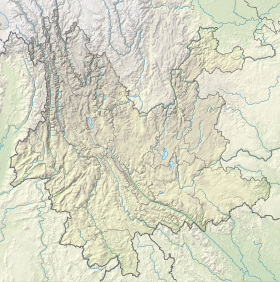
Back Esquistos de Maotianshan AST Esquistos de Maotianshan Catalan Maotchienšanské břidlice Czech Maotianshan-Schiefer German Maotianshan Shales English Esquistos de Maotianshan Spanish Maotianshan Shales Basque Serpih Maotianshan ID Maotianshan Italian 澄江動物群 Japanese
| Schistes de Maotianshan | |
 Affleurement des schistes de Maotianshan sur le site fossilifère de Chengjiang. | |
| Localisation | |
|---|---|
| Coordonnées | 24° 40′ nord, 102° 59′ est |
| Pays | |
| Xian | Chengjiang |
| Informations géologiques | |
| Période | Étage 3[1], Cambrien inférieur (étage géologique local : Qiongzhusian[2],[3]) |
| Âge | 518 Ma |
| Province géologique | Mont Maotian (plateforme du Yangzi Jiang)[3],[4] |
| Regroupé dans | Formation de Yu'anshan[5],[6],[7] |
| Nommé par | Ho, 1942[8],[9],[3],[10] |
| Formation supérieure | Siltite[5],[6],[7] |
| Formation inférieure | Shale noir[5],[6],[7] |
| Puissance moyenne | 50[5] 60[6],[7] |
| Lithologie principale | Shale |
| Lithologie secondaire | Mudstone |
| modifier |
|

Les schistes de Maotianshan constituent le membre intermédiaire de la formation géologique dite formation de Yu'anshan dans la province de Yunnan en Chine, dans les villages d'Ercaicun et de Chengjiang (près de Kunming).
- (en) M. H. Hofmann et al., « Provenance and temporal constraints of the Early Cambrian Maotianshan Shale, Yunnan Province, China », Gondwana Research, vol. 37, , p. 348-361 (lire en ligne [PDF], consulté le ).
- (en) Paul Selden et John Nudds, chap. 3 « Chengjiang », dans Evolution of Fossil Ecosystems, Elsevier, (lire en ligne).
- (en) Chengjiang Fossil Site, Ministry of Housing and Urban-Rural Development of the People's Republic of China, (lire en ligne [PDF]).
- (en) Hou Xianguag, Richard J. Aldridge, Jan Bergström et al., The Cambrian Fossils of Chengjiang, China : The Flowering of Early Animal Life, John Wiley & Sons, (lire en ligne).
- (en) J. Y. Chen, « The Lower Cambrian Maotianshan Shale: A Unique Window on the Cambrian Explosion », dans John A. Talent, Earth and Life: Global Biodiversity, Extinction Intervals and Biogeographic Perturbations Through Time, Springer Science & Business Media, (lire en ligne).
- (en) Stephen Q.Dornbos, David J.Bottjer et Jun-YuanChen, « Paleoecology of benthic metazoans in the Early Cambrian Maotianshan Shale biota and the Middle Cambrian Burgess Shale biota: evidence for the Cambrian substrate revolution », dans Loren E. Babcock, Interpretation of Biological and Environmental Changes Across the Neoproterozoic-Cambrian Boundary, Elsevier, (lire en ligne).
- (en) Tristan J. Klossa, Stephen Q. Dornbosa et Jun-Yuan Chen, « Paleoecology and taphonomy of the Early Cambrian Maotianshan Shale biotachancelloriid Allonnia junyuani: Adaptation to nonactualistic Cambrian substrates », Palaeogeography, Palaeoclimatology, Palaeoecology, no 277, (lire en ligne, consulté le ).
- (en) Xianguang Hou et Jan Bergström, « The Chengjiang fauna — the oldest preserved animal community », Paleontological Research, vol. 7, no 1, , p. 55-70 (lire en ligne, consulté le ).
- (en) Shouxin Zhang (dir.), Geological Formation Names of China (1866—2000), vol. I, Springer Science & Business Media, (lire en ligne).
- (en) Xianguang Hou et Jan Bergström, Arthropods of the Lower Cambrian Chengjiang fauna, southwest China, Scandinavian University Press, coll. « Fossils and Strata » (no 45), (lire en ligne [PDF]).

